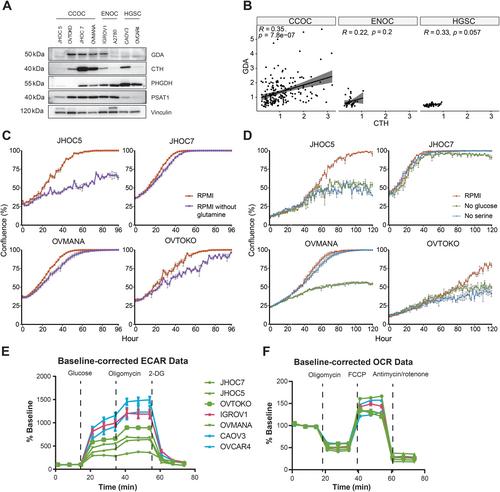Jennifer X Ji, Lien N Hoang, Dawn R Cochrane, Amy Lum, Janine Senz, David Farnell, Basile Tessier-Cloutier, David G Huntsman, Ramon I Klein Geltink
下载PDF
{"title":"透明细胞卵巢癌的独特代谢组。","authors":"Jennifer X Ji, Lien N Hoang, Dawn R Cochrane, Amy Lum, Janine Senz, David Farnell, Basile Tessier-Cloutier, David G Huntsman, Ramon I Klein Geltink","doi":"10.1002/path.6329","DOIUrl":null,"url":null,"abstract":"<p>Clear cell ovarian carcinoma (CCOC) is an aggressive malignancy affecting younger women. Despite ovarian cancer subtypes having diverse molecular and clinical characteristics, the mainstay of treatment for advanced stage disease remains cytotoxic chemotherapy. Late stage CCOC is resistant to conventional chemotherapy, which means a suboptimal outcome for patients affected. Despite detailed genomic, epigenomic, transcriptomic, and proteomic characterisation, subtype-specific treatment for CCOC has shown little progress. The unique glycogen accumulation defining CCOC suggests altered metabolic pathway activity and dependency. This study presents the first metabolomic landscape of ovarian cancer subtypes, including 42 CCOC, 20 high-grade serous and 21 endometrioid ovarian carcinomas, together comprising the three most common ovarian carcinoma subtypes. We describe a distinct metabolomic landscape of CCOC compared with other ovarian cancer subtypes, including alterations in energy utilisation and cysteine metabolism. In addition, we identify CCOC-specific alterations in metabolic pathways including serine biosynthesis and ROS-associated pathways that could serve as potential therapeutic targets. Our study provides the first in-depth study into the metabolome of ovarian cancers and a rich resource to support ongoing research efforts to identify subtype-specific therapeutic targets that could improve the dismal outcome for patients with this devastating malignancy. © 2024 The Author(s). <i>The Journal of Pathology</i> published by John Wiley & Sons Ltd on behalf of The Pathological Society of Great Britain and Ireland.</p>","PeriodicalId":232,"journal":{"name":"The Journal of Pathology","volume":"264 2","pages":"160-173"},"PeriodicalIF":5.6000,"publicationDate":"2024-08-03","publicationTypes":"Journal Article","fieldsOfStudy":null,"isOpenAccess":false,"openAccessPdf":"https://onlinelibrary.wiley.com/doi/epdf/10.1002/path.6329","citationCount":"0","resultStr":"{\"title\":\"The unique metabolome of clear cell ovarian carcinoma\",\"authors\":\"Jennifer X Ji, Lien N Hoang, Dawn R Cochrane, Amy Lum, Janine Senz, David Farnell, Basile Tessier-Cloutier, David G Huntsman, Ramon I Klein Geltink\",\"doi\":\"10.1002/path.6329\",\"DOIUrl\":null,\"url\":null,\"abstract\":\"<p>Clear cell ovarian carcinoma (CCOC) is an aggressive malignancy affecting younger women. Despite ovarian cancer subtypes having diverse molecular and clinical characteristics, the mainstay of treatment for advanced stage disease remains cytotoxic chemotherapy. Late stage CCOC is resistant to conventional chemotherapy, which means a suboptimal outcome for patients affected. Despite detailed genomic, epigenomic, transcriptomic, and proteomic characterisation, subtype-specific treatment for CCOC has shown little progress. The unique glycogen accumulation defining CCOC suggests altered metabolic pathway activity and dependency. This study presents the first metabolomic landscape of ovarian cancer subtypes, including 42 CCOC, 20 high-grade serous and 21 endometrioid ovarian carcinomas, together comprising the three most common ovarian carcinoma subtypes. We describe a distinct metabolomic landscape of CCOC compared with other ovarian cancer subtypes, including alterations in energy utilisation and cysteine metabolism. In addition, we identify CCOC-specific alterations in metabolic pathways including serine biosynthesis and ROS-associated pathways that could serve as potential therapeutic targets. Our study provides the first in-depth study into the metabolome of ovarian cancers and a rich resource to support ongoing research efforts to identify subtype-specific therapeutic targets that could improve the dismal outcome for patients with this devastating malignancy. © 2024 The Author(s). <i>The Journal of Pathology</i> published by John Wiley & Sons Ltd on behalf of The Pathological Society of Great Britain and Ireland.</p>\",\"PeriodicalId\":232,\"journal\":{\"name\":\"The Journal of Pathology\",\"volume\":\"264 2\",\"pages\":\"160-173\"},\"PeriodicalIF\":5.6000,\"publicationDate\":\"2024-08-03\",\"publicationTypes\":\"Journal Article\",\"fieldsOfStudy\":null,\"isOpenAccess\":false,\"openAccessPdf\":\"https://onlinelibrary.wiley.com/doi/epdf/10.1002/path.6329\",\"citationCount\":\"0\",\"resultStr\":null,\"platform\":\"Semanticscholar\",\"paperid\":null,\"PeriodicalName\":\"The Journal of Pathology\",\"FirstCategoryId\":\"3\",\"ListUrlMain\":\"https://onlinelibrary.wiley.com/doi/10.1002/path.6329\",\"RegionNum\":2,\"RegionCategory\":\"医学\",\"ArticlePicture\":[],\"TitleCN\":null,\"AbstractTextCN\":null,\"PMCID\":null,\"EPubDate\":\"\",\"PubModel\":\"\",\"JCR\":\"Q1\",\"JCRName\":\"ONCOLOGY\",\"Score\":null,\"Total\":0}","platform":"Semanticscholar","paperid":null,"PeriodicalName":"The Journal of Pathology","FirstCategoryId":"3","ListUrlMain":"https://onlinelibrary.wiley.com/doi/10.1002/path.6329","RegionNum":2,"RegionCategory":"医学","ArticlePicture":[],"TitleCN":null,"AbstractTextCN":null,"PMCID":null,"EPubDate":"","PubModel":"","JCR":"Q1","JCRName":"ONCOLOGY","Score":null,"Total":0}
引用次数: 0
引用
批量引用


 求助内容:
求助内容: 应助结果提醒方式:
应助结果提醒方式:


